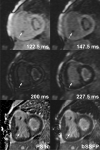Usefulness of TI-scout images in the assessment of late gadolinium enhancement in children
- PMID: 33731161
- PMCID: PMC7972209
- DOI: 10.1186/s12968-021-00719-2
Usefulness of TI-scout images in the assessment of late gadolinium enhancement in children
Abstract
Background: Cardiovascular magnetic resonance (CMR) late gadolinium enhancement (LGE) requires identification of the normal myocardial nulling time using inversion time (TI)-scout imaging sequence. Although TI-scout images are not primarily used for myocardial assessment, they provide information regarding different signal recovery patterns of normal and abnormal myocardium facilitating identification of LGE in instances where standard LGE images alone are not diagnostic. We aimed to assess the diagnostic performance of TI-scout as compared to that of standard LGE images.
Methods: CMR studies with LGE imaging in 519 patients (345 males, 1-17 years) were reviewed to assess the diagnostic performance of LGE imaging in terms of the location of LGE and the pathologic entities. The diagnostic performance of the TI-scout and standard LGE imaging was classified into four categories: (1) equally diagnostic, (2) TI-scout superior to standard LGE, (3) standard LGE superior to TI-scout, and (4) complementary, by the consensus of the two observers.
Results: The study cohort consisted of 440 patients with negative LGE and 79 with evidence for LGE. For a negative diagnosis of LGE, TI-scout and standard LGE images were equally diagnostic in 75% of the cases and were complementary in 12%. For patients with LGE, TI-scout images were superior to standard LGE images in 52% of the cases and were complementary in 19%. The diagnostic performance of TI-scout images was superior to that of standard LGE images in all locations. TI-scout images were superior to standard LGE images in 11 of 12 (92%) cases with LGE involving the papillary muscles, in 7 /12 (58%) cases with subendocardial LGE, and in 4/7 (57%) cases with transmural LGE. TI-scout images were particularly useful assessing the presence and extent of LGE in hypertrophic cardiomyopathy (HCM). TI-scout was superior to standard LGE in 6/10 (60%) and was complementary in 3/10 (30%) of the positive cases with HCM.
Conclusions: TI-scout images enhance the diagnostic performance of LGE imaging in children.
Keywords: Fibrosis; Late gadolinium enhancement; Look-Locker; Magnetic resonance; Myocardium; TI-scout.
Conflict of interest statement
The authors declare that they have no competing interests.
Figures





References
-
- Francis R, Kellman P, Kotecha T, Baggiano A, Norrington K, Martinez-Naharro A, et al. Prospective comparison of novel dark blood late gadolinium enhancement with conventional bright blood imaging for the detection of scar. J Cardiovasc Magn Reson. 2017;19:91. doi: 10.1186/s12968-017-0407-x. - DOI - PMC - PubMed
MeSH terms
Substances
LinkOut - more resources
Full Text Sources
Other Literature Sources
Medical

